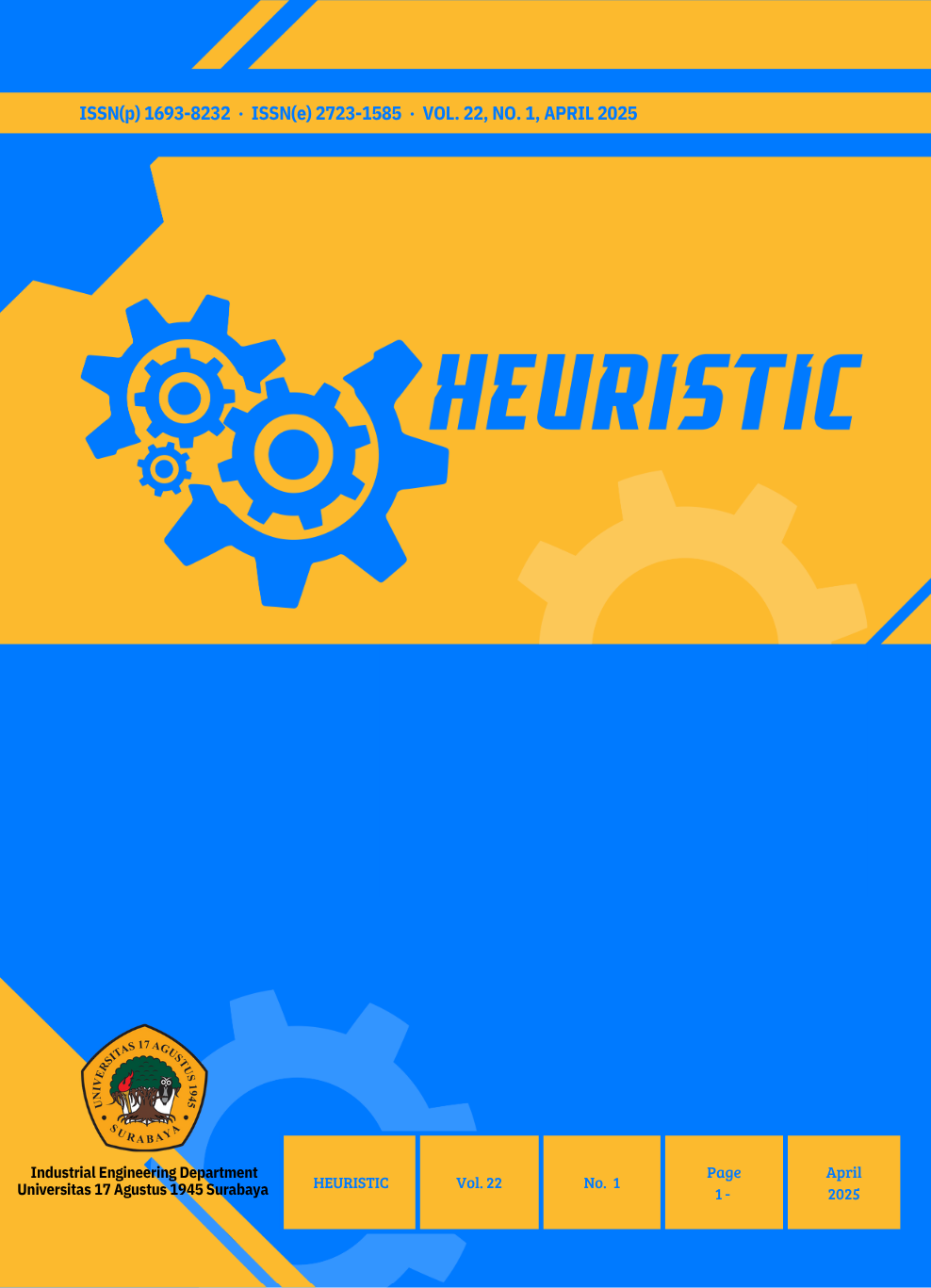Production Line Arrangement to Increase Output in order to Meet PT. DMR's Delivery Time in Surabaya
Abstract
PT DMR is a job order that produces ± 285 product items. This study focuses on 3 items, namely Wheels (wheels 30, 40, and 50), Hinge T 86, and Handle 28. Currently, the company has not been able to determine the capacity of each production line and has not been able to determine the Delivery Time accurately. The company wants to know and increase its production capacity so that it can be determined when the Delivery Time is on time. The analysis method used is the arrangement of the production line with line balance. After the calculation and analysis, it was obtained that the efficiency of the Wheel 40 product line increased from 52.43% to 78.19%, Balance Delay decreased from 47.57% to 21.87%, while the Cycle Time of production operations decreased from 15.84 "to 9.00", this occurred due to the use of expanded mattress holes from 10 holes to 14 holes. Wheel 50 experienced an increase in track efficiency from 48.83% to 95.31%, with a decrease in Balance Delay from 51.17 to 4.69, while for the Cycle Time of operations decreased from 19.52 "to 10.00", this occurred due to the use of expanded mattress holes from 8 holes to 12 mattress holes. Hinge T 86 increased from 46.40% to 50.3%, with balance delay decreased from 53.60% to 49.7%, while the operating Cycle Time decreased from 28.8” to 26.58”, an increase due to the addition of outsourcing capacity from 6000 pieces / 2 days to 7000 pieces / 2 days, namely by adding other sources, or still with the condition of additional outsourcing capacity. Handle 28 was not changed because the calculation results showed a production line efficiency of 93.3% (quite high) and Balance Delay 6.7%.Downloads
References
Buffa, Elwood S. & Rakesh K. Sarin. (1995). Moderen Production and Operation Manajemen, London: John Wiley & Sons. Inc.
Daelima, V. Dkk (2013). Analisis keseimbangan lintasan untuk meningkatkan kapasitas produksi dengan pendekatan line balancing dan simulasi. Jurnal Teknik Industri, vol. 1 No. 2 Juni 2013.
Dharmayanti, I. Dan Marliansyah, H. (2019). Perhitungan efektifitas lintasan produksi menggunakan metode Line Balancing. Jurnal Manajemen Industri dan Logistik. Vol. 03 No. 01 (2019).
Gaspersz, V. (1998). Production Planning and Inventory Control: Berdasakan Pendekatan Sistem Terintegrasi MRP II dan JIT Menuju Manufaktturing 21., Jakarta: PT. Gramedia Pustaka Utama.
Gaspersz, V. (2002). Production Planning And Inventory Control. Edisi Revisi. Jakarta: PT. Gramedia Pustaka Utama.
Ginting, R. (2007). Sistem Produksi. Edisi Pertama. Yogyakarta : Graha ilmu
Herdiani, L. and Nurcahyo, Rico S. (2018). Line Balancing untuk tercapainya Efisiensi kerja Optimal pada stasiun kerja. Universitas Langlangbuana. Bandung.
Nasution, A.H. (2003). Perencanaan Dan Pengendalian Produksi. Edisi 1. Surabaya: Penerbit Guna Widya, Institut Teknologi 10 Nopember.
Purnamasari, I. Dan Cahyana A. (2015). Line balancing dengan metode Ranked Position Weight (RPW). Spektrum Industri, 2015 vol. 13 No. 2
Render,B. dan Heizer, J. (2005). Manajemen Operasi. Edisi Ketujuh. Jakarta : Salemba Empat
Sutalaksana, Iftikar Z. dkk, (1979) Teknik tata cara Kerja, Jurusan Teknik Industri Institut Teknologi Bandung.
Viale, J. David., (1995). Basics of Manufacturing, Fundamental Concepts for Decision Makers. NY: Crisp Publications, Inc.
Wignyosubroto, S. (1992). Teknik Tata Cara Dan Pengukuran Kerja. Jakarta: Penerbit Guna Widya.
Yamit, Z. (1998). Manajemen Produksi dan Operasi. Edisi-1 Yogyakarta : Ekonisia.
Zutalaksana, IZ.( 1979). Teknik Tata Cara Kerja., Bandung: Penerbit Jurusan Teknik Industri ITB
Authors who publish with Heuristic agree to the following terms:
- Authors transfer the copyright and grant the journal right of first publication with the work simultaneously licensed under a Creative Commons Attribution-ShareAlike 4.0 International License.. that allows others to share the work with an acknowledgement of the work's authorship and initial publication in this journal.
- Authors are able to enter into separate, additional contractual arrangements for the non-exclusive distribution of the journal's published version of the work (e.g., post it to an institutional repository or publish it in a book), with an acknowledgement of its initial publication in this journal.
- Authors are permitted and encouraged to post their work online (e.g., in institutional repositories or on their website) prior to and during the submission process, as it can lead to productive exchanges, as well as earlier and greater citation of published work (See The Effect of Open Access)







